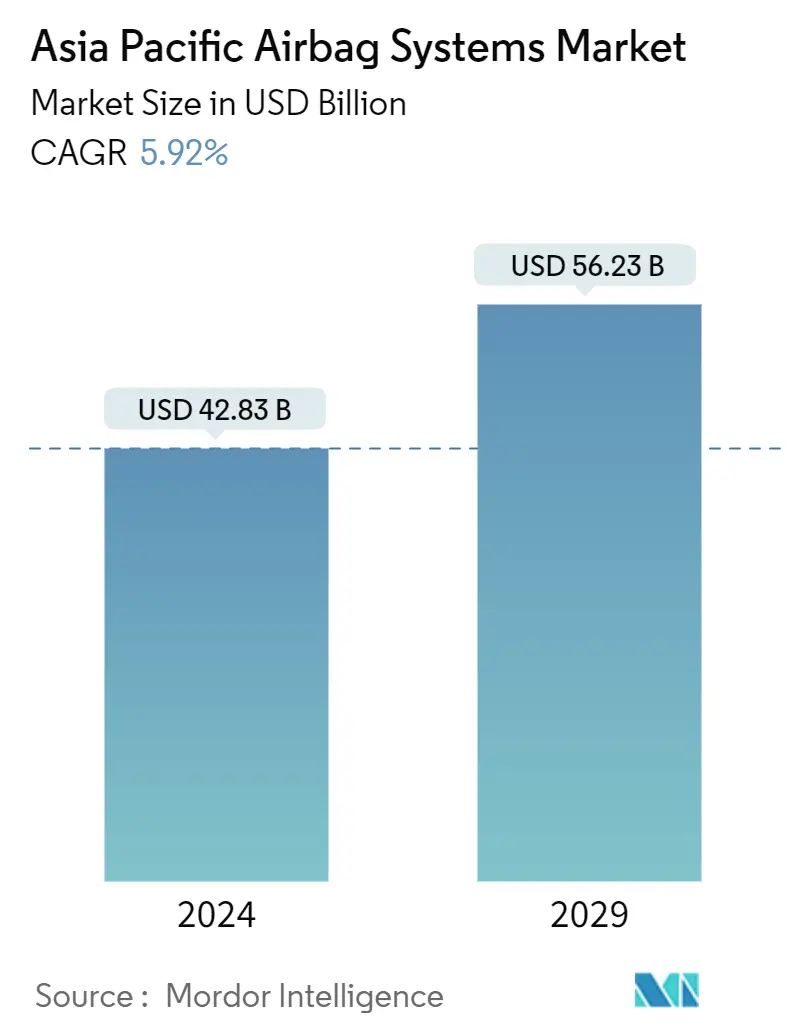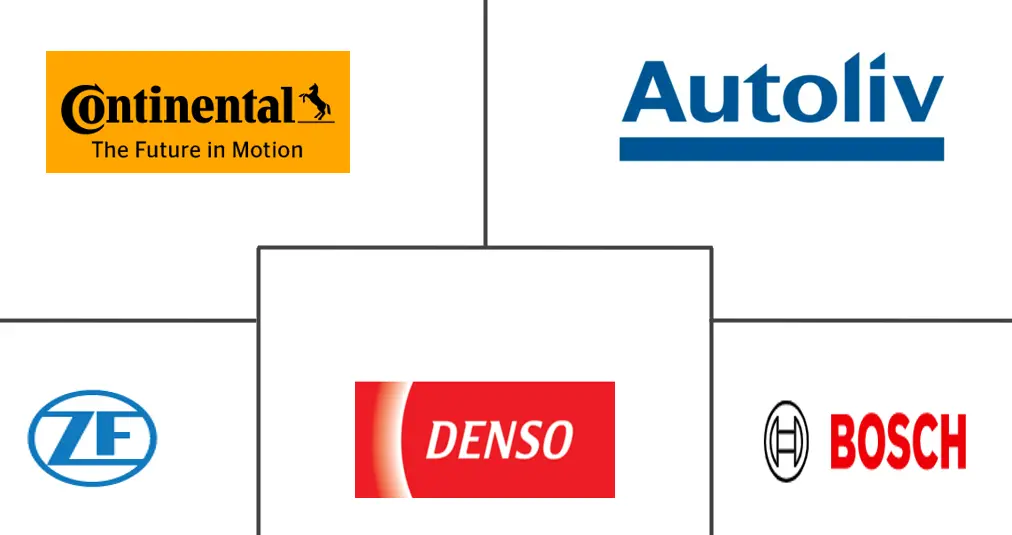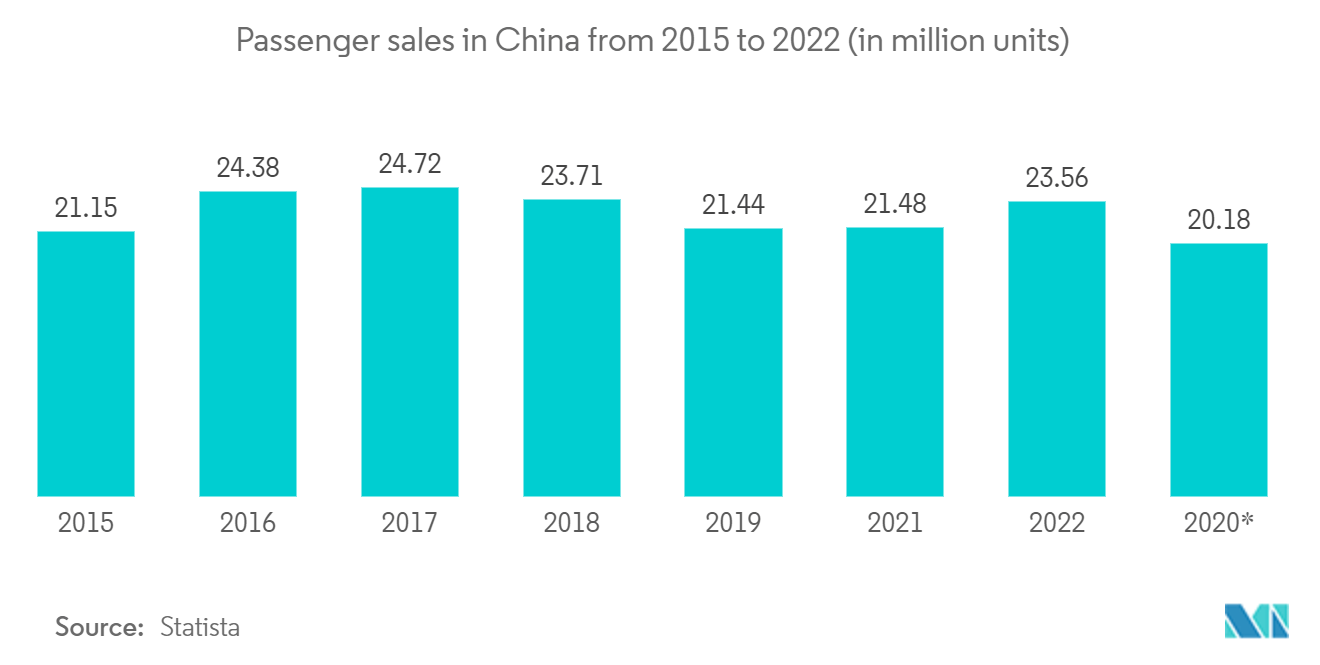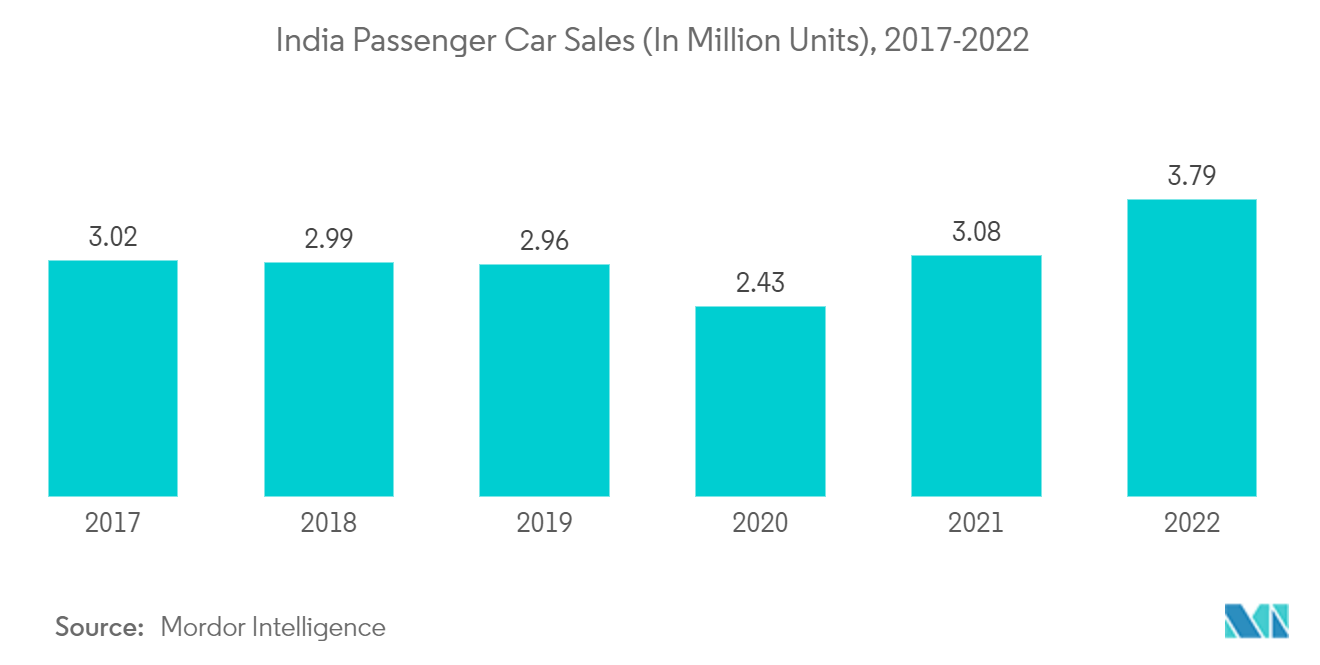Asia Pacific Airbag Systems Market Size

| Study Period | 2019 - 2029 |
| Base Year For Estimation | 2023 |
| Market Size (2024) | USD 42.83 Billion |
| Market Size (2029) | USD 56.23 Billion |
| CAGR (2024 - 2029) | 5.92 % |
| Market Concentration | High |
Major Players
*Disclaimer: Major Players sorted in no particular order |
Asia Pacific Airbag Systems Market Analysis
The Asia Pacific Airbag Systems Market size is estimated at USD 42.83 billion in 2024, and is expected to reach USD 56.23 billion by 2029, growing at a CAGR of 5.92% during the forecast period (2024-2029).
- Amid the halted vehicle production activities and disrupted supply chain due to the halt in transportation activities, the automotive airbag system market witnessed a significant slump for the year 2020. However, since 2021, as vehicle sales rebound and governing bodies focus on implementing stringent safety standards, the automotive airbag system market is anticipated to witness significant growth during the forecast period.
- Over the medium term, the growing consumer trend toward safety features in vehicles is likely to enhance the demand for airbag systems in the coming years. Regulations towards consumer safety and security have made manufacturers install safety devices in cars. The government of many countries has made the usage of airbags mandatory in vehicles. For instance, In 2021, The Indian Ministry of Road Transport and Highways mandated dual airbags in all types of vehicles.
- Over the long term, installing severe vehicle safety requirements and regulations drives the market. Furthermore, increasing road accidents and the growing desire for safer driving experiences will likely boost the market's growth in the coming years.
- According to the Indian Ministry of Road Transport and Highways Research Wing, a total number of 4,12,432 road accidents have been reported in the country in 2021. Such an increase in road accidents across the region is likely to enhance the demand for airbag systems during the forecast period.
Asia Pacific Airbag Systems Market Trends
Passenger Car Segment to Witness Momentum
China, which is the largest vehicle market in the world, has been backed up by generous support from the government. China has a major presence of automotive manufacturers, which is likely to create an opportunity for automotive component manufacturers to enhance their manufacturing facilities across the country which in turn is likely to witness major growth for the market during the forecast period.
India is one of the major automobile exporters, and strong export growth is expected in the near future seeing its present mobility expansion projects. Furthermore, multiple initiatives by the Government of India and major automakers in the Indian market are expected to portray India. During FY 2021-2022, In total, 3,069,499 passenger vehicles were sold overall, an increase from 2,711,457. Comparing April 2021 to March 2022, Passenger Car sales fell from 1,541,866 to 1,467,056 units, while Utility Vehicle sales rose from 1,060,750 to 1,489,178 units.
Over the long-term strategic stance, companies in the operation are looking ahead with strategic partnership in order to improve cars overall safety and thus witness improved demand. For instance:
- In July 2023, ZF Group signed an agreement with the administrative committee of the Wuhan Economic & Technological Development Zone (WEDZ), announcing an additional investment of 150 million euros ($166.5 million) to establish an automobile airbag production base and a research and development center. This project aims to create ZF Group's most extensive airbag production base in the Asia-Pacific region and a center for the trial production of new airbag prototypes.
Thus, market for automotive airbags are anticipated to witness high growth rate owing to increased passenger car sales across the Asia-Pacific.

India Dominating the Market
The Indian economy is expanding, as there is a rise in the disposable income of middle-class consumers. This, in turn, has a favorable impact on the increasing demand for automobiles. Vehicle manufacturing has increased rapidly over the last five years as a result of the country's cheap production costs. The automotive airbag system market is gaining traction as vehicle manufacturing increases.
Car manufacturers nowadays provide several helpful amenities for the driver and passengers, which in turn is likely to enhance the demand for airbag systems in vehicles.
Automobile manufacturers and auto-component makers choose India as one of their favored economies for setting up production plants. Several companies collaborated with the local automotive manufacturer to export the vehicles per government regulations. The Indian automotive and auto-ancillary industry is supported by several factors, including the availability of low-cost skilled labor, robust R&D centers, and low-cost steel production.
The Indian automotive airbag industry's fastest-growing segment is curtain airbags. They're generally installed on the roof above the side window, side of the seat, or door panel. Curtain airbags protect the adult's head in the event of a collision. Curtain airbags have been shown to minimize the probability of a driving fatality by 45 percent. Pedestrian airbags have been increasingly popular in recent years. When a car is poised to collide with a pedestrian, these are immediately deployed.

Asia Pacific Airbag Systems Industry Overview
Asia-Pacific Airbag Systems Market is dominated by several key players such as ZF Friedrichshafen AG, Autoliv Inc., DENSO Corporation, Continental AG, and others. Major key players are expanding their manufacturing facilities across the region, which is likely to witness major growth for the market during the forecast period. For instance,
In April 2022, Toyoda Gosei Co., Ltd. established a new plant in Guangdong Province, China, to enhance its production network for airbags and steering wheels, its major products. The facility was constructed on a site of about 54,000 square meters, which has a building area footprint of about 43,000 square meters. The plant manufactures airbags, steering wheels, and pop-up actuators.
In April 2022, Toyoda Gosei Co., Ltd. established a new plant in Guangdong Province, China, to enhance its production network for airbags and steering wheels, its major products. The facility was constructed on a site of approximately 54,000 square meters, with a building area footprint of about 43,000 square meters. The plant manufactures airbags, steering wheels, and pop-up actuators.
In March 2022, Asahi Kasei Corporation (Asahi Kasei) announced a strategic partnership with Genomatica, Inc. on March 16. The partnership aims to develop biomass-derived polyamide 66 (PA66), with Asahi Kasei gaining preferential use of Genomatica's biomass-derived hexamethylenediamine (HMD) technology. Asahi Kasei plans to combine its polymerization technology with HMD technology to commercialize biomass-derived PA66 in the future. PA66 finds applications in products like airbag fabrics and automotive plastic parts.
In December 2021, ZF Friedrichshafen AG (ZF) announced a joint venture (JV) with Rane TRW Steering Systems from the Rane Group. This joint venture will focus on producing safety products, airbags, and seat belt systems for both the domestic market and exports.
In March 2021, Autoliv announced its plans to establish an airbag inflator manufacturing plant in Chennai, India. Autoliv expects that the new plant will further support sustainable market growth in India, catering to the needs of global and local original equipment manufacturers (OEMs).
Asia Pacific Airbag Systems Market Leaders
-
Robert Bosch GmbH
-
Continental AG
-
ZF Friedrichshafen AG
-
Denso Corporation
-
Autoliv inc.
*Disclaimer: Major Players sorted in no particular order

Asia Pacific Airbag Systems Market News
- February 2023: Uno Minda announced an investment of USD 21.16 million in Rajasthan, India. Through this expansion, the company expanded its airbag manufacturing facility across the country.
- May 2022: Yanfeng and US-based company ARC Automotive announced the formation of a new joint venture for the production of airbag inflators for airbag applications.
APAC Airbag Systems Market Report - Table of Contents
1. INTRODUCTION
1.1 Study Assumptions
1.2 Scope of the Study
2. RESEARCH METHODOLOGY
3. EXECUTIVE SUMMARY
4. MARKET DYNAMICS
4.1 Market Drivers
4.1.1 Stringent Safety Standards Implemented by Governing Bodies
4.1.2 Others
4.2 Market Restraints
4.2.1 Volatility in Raw Material Price
4.2.2 Others
4.3 Porters Five Forces Analysis
4.3.1 Threat of New Entrants
4.3.2 Bargaining Power of Buyers/Consumers
4.3.3 Bargaining Power of Suppliers
4.3.4 Threat of Substitute Products
4.3.5 Intensity of Competitive Rivalry
5. MARKET SEGMENTATION (Market Size in Value - USD Billion)
5.1 Airbag Type
5.1.1 Curtain
5.1.2 Front
5.1.3 Knee
5.1.4 Sire
5.1.5 Other Airbag Types
5.2 Vehicle Type
5.2.1 Passenger Vehicles
5.2.2 Commercial Vehicles
5.2.3 Busses
5.2.4 Trucks
5.3 Sales Channel
5.3.1 OEMs
5.3.2 Aftermarket
5.4 Geography
5.4.1 China
5.4.2 Japan
5.4.3 India
5.4.4 South Korea
5.4.5 Rest of Asia-Pacific
6. COMPETITIVE LANDSCAPE
6.1 Vendor Market Share
6.2 Company Profiles*
6.2.1 Hyundai Mobis Co Ltd
6.2.2 ZF Friedrichshafen AG
6.2.3 Autoliv Inc.
6.2.4 Denso Corporation
6.2.5 Toshiba Corporation
6.2.6 Continental AG
6.2.7 Robert Bosch GmbH
6.2.8 GWR safety systems
6.2.9 Key Safety Systems
6.2.10 Joyson Safety Systems
6.2.11 Yanfeng KSS (Shanghai) Automotive Safety Systems Co., Ltd.
6.2.12 Toyoda Gosei Co. Ltd.
7. MARKET OPPORTUNITIES AND FUTURE TRENDS
Asia Pacific Airbag Systems Industry Segmentation
An automotive airbag system is a passive system that is installed in the steering wheel of the vehicle that protects occupants from hitting the vehicle interior or objects outside the vehicle during a collision.
The Asia-Pacific airbag system market is segmented into airbag type, vehicle type, sales channel, and country. Based on the airbag type, the market is segmented into curtain, front, knee, side, and other. Based on the vehicle type, the market is segmented into passenger, commercial, busses, and trucks. Based on the sales channel, the market is segmented into OEM and aftermarket. Based on geography, the market is segmented into China, India, Japan, South Korea, and the Rest of Asia-Pacific.
For each segment, the market sizing and forecast have been done based on the value (USD).
| Airbag Type | |
| Curtain | |
| Front | |
| Knee | |
| Sire | |
| Other Airbag Types |
| Vehicle Type | |
| Passenger Vehicles | |
| Commercial Vehicles | |
| Busses | |
| Trucks |
| Sales Channel | |
| OEMs | |
| Aftermarket |
| Geography | |
| China | |
| Japan | |
| India | |
| South Korea | |
| Rest of Asia-Pacific |
APAC Airbag Systems Market Research FAQs
How big is the Asia Pacific Airbag Systems Market?
The Asia Pacific Airbag Systems Market size is expected to reach USD 42.83 billion in 2024 and grow at a CAGR of 5.92% to reach USD 56.23 billion by 2029.
What is the current Asia Pacific Airbag Systems Market size?
In 2024, the Asia Pacific Airbag Systems Market size is expected to reach USD 42.83 billion.
Who are the key players in Asia Pacific Airbag Systems Market?
Robert Bosch GmbH, Continental AG, ZF Friedrichshafen AG, Denso Corporation and Autoliv inc. are the major companies operating in the Asia Pacific Airbag Systems Market.
What years does this Asia Pacific Airbag Systems Market cover, and what was the market size in 2023?
In 2023, the Asia Pacific Airbag Systems Market size was estimated at USD 40.29 billion. The report covers the Asia Pacific Airbag Systems Market historical market size for years: 2019, 2020, 2021, 2022 and 2023. The report also forecasts the Asia Pacific Airbag Systems Market size for years: 2024, 2025, 2026, 2027, 2028 and 2029.
Asia Pacific Airbag Systems Industry Report
Statistics for the 2024 Asia Pacific Airbag Systems market share, size and revenue growth rate, created by Mordor Intelligence™ Industry Reports. Asia Pacific Airbag Systems analysis includes a market forecast outlook to for 2024 to 2029 and historical overview. Get a sample of this industry analysis as a free report PDF download.



